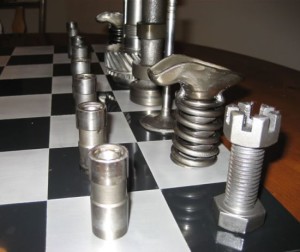Reynard Gelderblom (@Reynardg), Motorsport Editor of Street Motion sent us his thoughts on the role that strategy plays in Formula one, following the Chinese Grand Prix.
If you’d like us to publish your Formula One related opinions, just email us and we’ll add it to the Fan Pages of this website.
F1: A game of chess, not checkers
A thought which came up quite a few times while watching this past weekend’s Chinese Grand Prix is: “I don’t ever want to play chess against any of these team managers.”
F1 is very much about strategy these days, with the tyres playing a huge part of planning throughout the weekend. All of us will still remember this same race in 2012 where one lap meant the difference between second and fourteenth for Kimi Raikkonen.
I’ve heard many complaints over the past weekend though from people calling this boring, most notably during the third qualifying session on Saturday. For me, this was extremely exciting. Then again, whenever I go to the casino you’ll be sure to find me at the Blackjack table and never at a slot machine. Formula One is truly the thinking man’s sport.
The race weekend starts on Friday morning with all teams receiving an equal amount of tyres from two Pirelli compounds. Friday practice teams need to gather enough information about the tyres, how long they’ll last, what will work in which conditions etc. Come Saturday morning, your strategy for tyres needs to be in place. Effectively Saturday qualifying is when you start your race these days. A good example was with Red Bull in China. There’s no doubt that Vettel could’ve qualified higher than ninth, but making up grid slots would’ve cost the team dearly in the race.
Then comes the race: Webber’s failure to supply a fuel sample after qualifying got him pushed to the back of the grid. Again the team took advantage of this by changing the gearbox and gear ratios and thereby willingly choosing to start from the pits. Hamilton started first with Alonso third. Again, Alonso could’ve easily gotten pole position, but at what cost? As the race progressed, this played out as expected.
Then there was the question of the option tyre. All teams must make use of both tyre compounds during a normal dry race. For this race, Pirelli’s softer compound clearly had no real lifespan to talk of – just six laps. Most teams just wanted to get this over and done with. For this one, Vettel had an entirely different strategy to anyone else: take the option tyres with six laps to go. All of a sudden, Hamilton was under pressure and with one lap to go third spot would’ve gone to the one who could keep it together on the tyres.
Of course fingers can be pointed to Pirelli. Shouldn’t they maybe have supplied the teams with better tyres? Shouldn’t they gather as much team data as they can to come up with a better solution? One thing to keep in mind is that this is not 2005 when tyre changes weren’t allowed. We certainly won’t see any scenes like we did back in the USA Grand Prix of that year where all but six cars pulled off the circuit prior to the start for safety reasons. Tyre changes are part of the game now – and it’s a variable teams have to take into account.
What’s more, it does in fact bring a level of excitement to a GP as well. I watched this race along with another group of motoring journalists at one of our favourite restaurants in Cape Town. I can’t remember when last it took me an hour to finish a proper fried up breakfast and the reason for this is simply because I didn’t want to look away from the screen. I didn’t want to miss any slight sign of the tyres starting to fade on someone’s car or a single radio message. This was pure thrills from start to finish.
Balancing equations of minimum quantities of fuel, KERS, DRS, tyres, ideal track position after pit stops, when to make what move… all while trying to win a race. As I said, I wouldn’t want to play a game of chess against these guys.
By Reynard Gelderblom
Reynard Gelderblom is the motorsport editor for Street Motion.
Keep up with the latest local motorsport news by following for Street Motion on Twitter.




